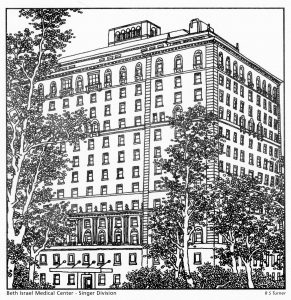For more information about former Beth Israel locations, see the Building Beth Israel series. An interactive map of Beth Israel historical locations is available here. See all our holdings related to the Jewish Maternity Hospital, Doctors Hospital, and the Singer Division.
Mount Sinai Beth Israel has affiliated with several hospitals over its 130-year history. Though their names may have disappeared over time, their impact on the hospital’s history remains. This blog post looks at two Beth Israel affiliates, Jewish Maternity Hospital and Doctors Hospital, and their lasting influence on Beth Israel.
Jewish Maternity Hospital
The Jewish Maternity Hospital (JMH) first opened in February 1909 at 270 East Broadway with two consulting physicians, twelve house staff, and fifteen obstetrical nurses. By 1927, JMH accumulated a large building fund and wanted to expand its premises. The Jewish Federation of Philanthropies, which helped to fund many of the local Jewish hospitals during this period, preferred that it become part of a larger hospital rather than be maintained as a separate institution.
As another hospital funded by the Federation, not to mention a close neighbor on the Lower East Side, Beth Israel was a natural candidate – however, the proposed merger was not without controversy. At a 1928 meeting of the Board of Trustees, Beth Israel Superintendent Louis J. Frank firmly rejected it as an unwarranted drain on the space and resources and recommended that a separate building on the Beth Israel campus be constructed so that JMH did not take over beds in the newly built Dazian Pavillion. He also suggested that JMH consider affiliating with The Mount Sinai Hospital instead. (Prior to the Federation’s merger proposal, JMH had planned to construct a new building on 108th Street.) Board President Cohen, however, noted that control of the Maternity Hospital’s $700,000 building fund would enable Beth Israel to solve the financial difficulties caused by cost overruns for the construction of Dazian.
Later that year, a compromise was reached. The Federation proposed that Beth Israel absorb the JMH, that the boards of the two institutions merge (with a subcommittee for the newly formed maternity department consisting of the former JMH trustees), and that Beth Israel allocate beds in the new building specifically for obstetrical purposes. A motion was approved to accept the proposal, albeit reluctantly, with the Board noting that it “did not invite the merger, nor does it feel that there is any need or emergency, as far as Beth Israel Hospital is concerned… since provision has already been made in the new building for an adequate, efficient and up to date Maternity Service.”
The merger was announced in 1929 and finally occurred in 1930. Plans to construct a new building for the hospital adjacent to the Beth Israel campus in Stuyvesant Square were announced in 1931, though this building was never completed. Over the next decade, obstetrical services slowly transitioned to the Beth Israel campus, and in 1946, the JMH name disappeared. In 1948, the Obstetrics service notes, “the long-awaited physical consolidation of all labor and delivery rooms is effected.”
Doctors Hospital
Construction for Doctors Hospital began in 1929, amid a debate in the larger medical world about the necessity of private rooms versus the larger, shared wards common to the nineteenth century. When it opened in 1930, Doctors Hospital was described as “homelike,” “a model hospital with the atmosphere of a modern hotel” with “soft tinted walls, guest rooms and a private icebox…for every patient.” With its unusually well-equipped private rooms, and its location at 70 East End Avenue overlooking Carl Schurz Park and Gracie Mansion, Doctors Hospital secured its reputation as being a luxe medical facility for the famous and well-to-do for the rest of the century.
On August 3, 1987, it was announced that Doctors Hospital had been acquired by Beth Israel Medical Center and was renamed Beth Israel North. The name changed again in 1998 to the Beth Israel Medical Center Singer Division. In these years, the Hospital had a few notable developments. In 1988, it acquired a device for treating gallstones and bile duct stones, called a biliary lithotripter. It was the first in New York City, and Charles McSherry, MD, spearheaded the project. In 1990, the New York State Department of Health approved a certificate of need for the construction of twenty-four chronic dialysis stations at the hospital due to a lack of such facilities in Manhattan.
However, the Singer Division did not last. By 2004, it was formally closed, and the property was sold to developers. The facility was torn down the following year and was replaced with apartments.
Sources:
- Beth Israel Hospital Board of Trustees minutes, 1927-1929
- Beth Israel Hospital Board of Trustees minutes, 1929-1989
- Connections: News and Information for Employees of Continuum Health Partners
- Eye on BI (vol. 3, no. 3), November 1987
- Eye on BI, Winter 1990
Authored by Stefana Breitwieser with research credit to Nicholas Webb


